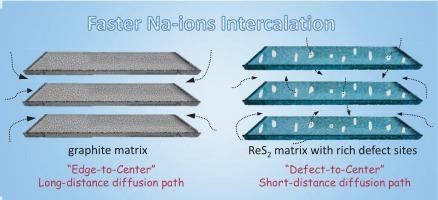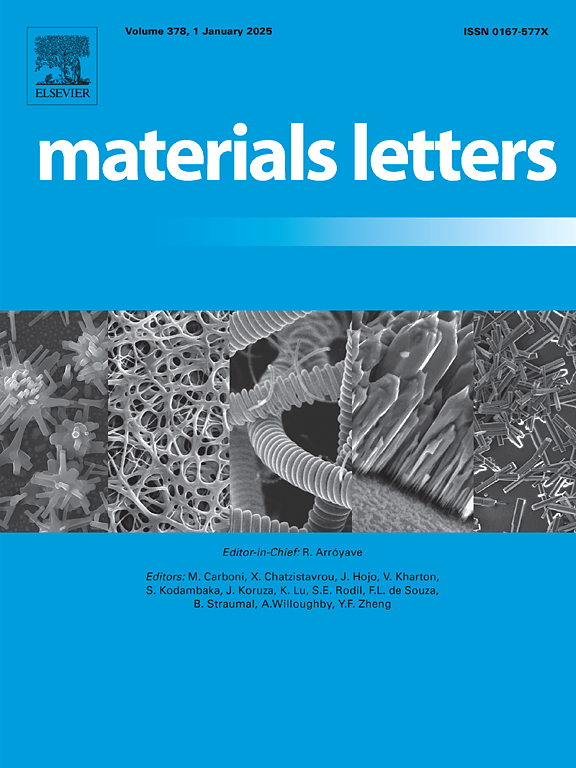缺陷向中心扩散机制下ReS2@rGO阳极的超快钠离子存储性能
IF 2.7
4区 材料科学
Q3 MATERIALS SCIENCE, MULTIDISCIPLINARY
引用次数: 0
摘要
ReS2材料是一种很有前途的钠离子电池负极材料。然而,它们的实际应用受到低导电性和显着的体积膨胀的阻碍,导致容量迅速退化。本研究构建了一种ReS2@rGO材料,在该材料中,rGO基质有效地增强了ReS2的导电性和结构稳定性。更重要的是,利用ReS2大的层间距和丰富的缺陷结构,ReS2@rGO材料可以通过短距离的“缺陷到中心”扩散路径实现更快的Na-ion存储。由于这种独特的结构,ReS2@rGO具有优异的电化学性能,包括高比容量(403.8 mAh g−1)和卓越的循环稳定性(84.1%的保留率)。本文章由计算机程序翻译,如有差异,请以英文原文为准。

Ultrafast sodium-ion storage performance of ReS2@rGO anode enabled by defect-to-center diffusion mechanism
ReS2 materials are regarded as a promising anode material for sodium-ion batteries. However, their practical application is hindered by low electrical conductivity and significant volume expansion, leading to rapid capacity degradation. In this study, a ReS2@rGO material is constructed, in which the rGO matrix effectively enhances the electrical conductivity and structural stability of ReS2. More importantly, leveraging the large interlayer spacing and abundant defect structure of ReS2, the ReS2@rGO materials enable faster Na-ion storage through short-distance “defect-to-center” diffusion pathways. Owing to this unique architecture, ReS2@rGO demonstrates excellent electrochemical performance, including a high specific capacity (403.8 mAh g−1) and remarkable cycling stability (84.1 % retention rate).
求助全文
通过发布文献求助,成功后即可免费获取论文全文。
去求助
来源期刊

Materials Letters
工程技术-材料科学:综合
CiteScore
5.60
自引率
3.30%
发文量
1948
审稿时长
50 days
期刊介绍:
Materials Letters has an open access mirror journal Materials Letters: X, sharing the same aims and scope, editorial team, submission system and rigorous peer review.
Materials Letters is dedicated to publishing novel, cutting edge reports of broad interest to the materials community. The journal provides a forum for materials scientists and engineers, physicists, and chemists to rapidly communicate on the most important topics in the field of materials.
Contributions include, but are not limited to, a variety of topics such as:
• Materials - Metals and alloys, amorphous solids, ceramics, composites, polymers, semiconductors
• Applications - Structural, opto-electronic, magnetic, medical, MEMS, sensors, smart
• Characterization - Analytical, microscopy, scanning probes, nanoscopic, optical, electrical, magnetic, acoustic, spectroscopic, diffraction
• Novel Materials - Micro and nanostructures (nanowires, nanotubes, nanoparticles), nanocomposites, thin films, superlattices, quantum dots.
• Processing - Crystal growth, thin film processing, sol-gel processing, mechanical processing, assembly, nanocrystalline processing.
• Properties - Mechanical, magnetic, optical, electrical, ferroelectric, thermal, interfacial, transport, thermodynamic
• Synthesis - Quenching, solid state, solidification, solution synthesis, vapor deposition, high pressure, explosive
 求助内容:
求助内容: 应助结果提醒方式:
应助结果提醒方式:


